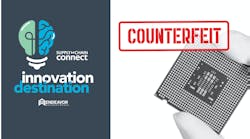Download this article in PDF format.
Counterfeit products may cost the global economy over $500 billion a year, but some enterprising organizations are coming up with new ways to thwart the “bad actors” and help stem the flow of these illegal goods. One method involves anti-counterfeit packaging that incorporates specific security features that both detect and deter counterfeit products.
The security features may be visible or invisible, with some examples that include the use of holograms to develop distinctive packaging that can’t be copied; security inks for tamper-evident packaging; and either radio frequency identification (RFID) tags or barcodes for tracking and identifying products.
Advanced Anti-Counterfeit Options
Some of the newer anti-counterfeit packaging incorporates blockchain or quantum cryptography, the latter of which utilizes quantum mechanics principles to create advanced types of tamper-proof packaging. These and other methods are being deployed by electronics, pharmaceutical, personal care and luxury goods manufacturers, all of which are on a mission to protect customers and consumers from counterfeit products.
Some anti-counterfeit packaging uses multiple different methods of thwarting the criminals and alerting consumers to the potential threats.
“Today’s counterfeiters can easily duplicate many of the safety features put into place to protect counterfeiting, so it is vital for food product manufacturers to use a multifaceted approach,” Combined Technologies, Inc. (CTI), explains. “Rather than using one anti-counterfeit technology, they need to use several. For example, utilizing holographic safety seals alongside difficult-to-duplicate RFID provides more protection than either one of these options alone.”
A $259 Billion Market by 2033
Over the next 10 years, the anti-counterfeit packaging market is expected to expand by about 5% compound annual growth rate (CAGR), which would bring the global sector’s value to about $259 billion. Compare this to the market’s current size of $160 billion, and it’s clear that companies see this as a real opportunity to make an impact in this particular market sector.
The anti-counterfeit packaging market in the U.S. will post a CAGR of 2.7% by 2033, while Canada will capture 3.6% of the global market by that time. Key players in the market sector include companies like Avery Dennison, 3M, DuPont, Zebra and SATO Holdings.
Future Market Insights Global and Consulting says the global anti-counterfeit packaging market is experiencing robust growth as the need for secure and tamper-evident packaging solutions continues to rise. “With the increasing prevalence of counterfeit products in various industries such as pharmaceuticals, food and beverages, and electronics, the demand for advanced anti-counterfeit technologies is on the ascent,” it says.
4 Key Trends to Watch
Some of the latest trends highlighted in the company’s report include:
- Companies are leveraging the power of digital technologies to create more advanced anti-counterfeit packaging options. These advanced packaging solutions are being used to record, analyze and track product journeys.
- Use of smart packaging is on the rise. Tracking barcodes, QR codes and NFC tags can all enhance smart packaging solutions for verifying product authenticity. These smart packaging solutions offer real-time verification of products and also help improve consumer engagement.
- Tamper-evident features are in demand. Manufacturers want more tamper-evident packaging, which helps ensure the safety of their products. These packaging solutions are in particular demand in the food and beverage, electronics and pharmaceutical sectors.
- All eyes are on sustainability. The research firm says growing demand for eco-friendly solutions that help reduce carbon footprints and promote recycling are also driving adoption of anti-counterfeit packaging.
All Together Now
Acknowledging that counterfeiting is a “big problem” for many different industries right now, CTI is hopeful that the problem can be curbed with good practices and innovations like anti-counterfeit packaging.
“When manufacturers, packagers, and retailers all work together to discover new ways to protect these products and the end users,” the company explains, “it’s possible to completely discourage counterfeiters, reduce crime, and protect the health and safety of the general public.”









